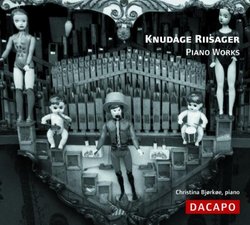Saucy Danish Neoclassic Piano Works with a French Tinge
J Scott Morrison | Middlebury VT, USA | 12/14/2004
(4 out of 5 stars)
"Knudage Riisager (1897-1974) was a Danish composer whose day job was as a department head in the nation's Ministry of Finance. But he always composed, having studied with Roussel and le Flem in France, and for most of his life was known primarily as a composer of music for the ballet. After his retirement from government service in 1956 he was tapped to be director of the Royal Academy of Music in Copenhagen. He was not a pianist but wrote a fair amount of music for the instrument which is presented here by young Danish pianist Kristin Bjorkoe.
Most of the music here is in Riisager's familiar neoclassic style. I have previously compared his approach to that of Poulenc or Françaix in that his piano works are marked by insouciant, forward-moving clarity and lightness. The only exception to that description on this disc is the first work presented, his Sonata Op. 22 (1931) which is rather more percussive, motoric, Bartókian. (Indeed, it was probably inspired by hearing Bartók play his own Sonata in Copenhagen in 1929.) It's not for nothing that the sonata's first movement is marked 'allegro intransigente' with its percussive obbligato figure and its naked fourths and fifths. After the 14-minute sonata, though, Riisager's more familiar style prevails. There are 'Deux Morceaux,' delicate miniatures that are over before you know it They are followed by what were probably rehearsal-piano transcriptions of four movements from one of Riisager's most-loved ballet scores, 'Slaraffenland' ('The Land of Cockaigne') with the languid 'Gyngestolen,' the amorous 'Princesse Sukkergodt,' and the sassy 'Springedanse.' There is also similarly transcribed 'Waltz' from another popular ballet, 'Tolv med posten' ('Twelve by Mail'). It is a wistful, gentle minor-key dance with a particularly memorable melody (and countermelody), played with nuance here by Bjorkoe.
The other piano pieces include the very French-sounding 'Sonatine' (1950), and 'Quatre Épigrammes' (1921, the earliest of his piano music to survive). There are four children's pieces ('Fire Borneklaverstykker,' 1964) which only last a total of three minutes. One of them, called 'Polytonal,' lasts only nine seconds, but illustrates another of Riisager's favorite stylistic traits, a use of bitonality similar to that of Milhaud. Finally, there is 'En glad Trompet og andre Klaverstykker' (1934, arranged from his Concerto for Trumpet and Strings) with its six tiny movements lasting only six minutes in all. The first of these, the 'Little Polka,' is a shy dance that gets bolder over its one-minute length. And the last is the 'Glad Trumpet' of the title, a cheerful finish to a cheerful little suite.
I find Riisager's music to be a tonic, particularly when I'm overburdened with cares and concerns. This is no profound music, but it is certainly profoundly cheering music.
Scott Morrison"

